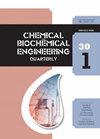阴离子粘土ZnAl-CO3煅烧去除水中调脂药物clofibracid的效果研究
IF 0.9
4区 生物学
Q4 BIOTECHNOLOGY & APPLIED MICROBIOLOGY
引用次数: 3
摘要
纤维酸(CA)被广泛用作血液中脂质水平的调节剂;它被认为是在水生环境中具有高持久性的残留药物之一。废水处理后,只能去除少量CA。本研究的目的是研究使用煅烧的阴离子粘土ZnAl-CO3来减少污染废水中的CA,选择ZnAl-CO3是因为它具有较高的吸附能力、可回收性和污泥的不可再生性。最大滞留量Qm超过2220 mg g-1, DH°值提示存在物理过程。去除率达到90%,残留量远低于容许阈值。吸附物分子之间的氢键和静电相互作用实现了保留。回收试验表明,与其他吸附剂相比,该材料是可回收的、有前途的、非常有效的。这种滞留有助于持久的脂质调节剂的衰减。本文章由计算机程序翻译,如有差异,请以英文原文为准。
Removal Efficiency of Lipid-regulating Drug Clofibric Acid from the Aquatic Environment by Calcined Anionic Clay ZnAl-CO3
Clofibric acid (CA) is widely used as regulator of lipid levels in blood; it is considered one of the residual drugs that have a high persistence in the aquatic environment. After wastewater treatment, only a small amount of CA can be removed. The aim of this work was to investigate the reduction of CA in contaminated wastewater using calcined anionic clay ZnAl-CO3, which was chosen for its higher adsorption capacity, recyclability, and non-regeneration of sludge. The maximum retention amount, Qm, exceeded 2220 mg g–1, and the value of DH° suggested a physical process. The removal rate achieved 90 %, and the remaining quantity was widely below the tolerance thresholds. Retention was achieved by hydrogen bonds and electrostatic interactions between the adsorbate molecules. Recycling tests clearly suggested that this material is recyclable, promising, and very effective compared to other adsorbents. This retention contributes to the attenuation of persistent lipid regulator.
求助全文
通过发布文献求助,成功后即可免费获取论文全文。
去求助
来源期刊
CiteScore
2.70
自引率
6.70%
发文量
23
审稿时长
>12 weeks
期刊介绍:
The journal provides an international forum for presentation of original papers, reviews and discussions on the latest developments in chemical and biochemical engineering. The scope of the journal is wide and no limitation except relevance to chemical and biochemical engineering is required.
The criteria for the acceptance of papers are originality, quality of work and clarity of style. All papers are subject to reviewing by at least two international experts (blind peer review).
The language of the journal is English. Final versions of the manuscripts are subject to metric (SI units and IUPAC recommendations) and English language reviewing.
Editor and Editorial board make the final decision about acceptance of a manuscript.
Page charges are excluded.

 求助内容:
求助内容: 应助结果提醒方式:
应助结果提醒方式:


